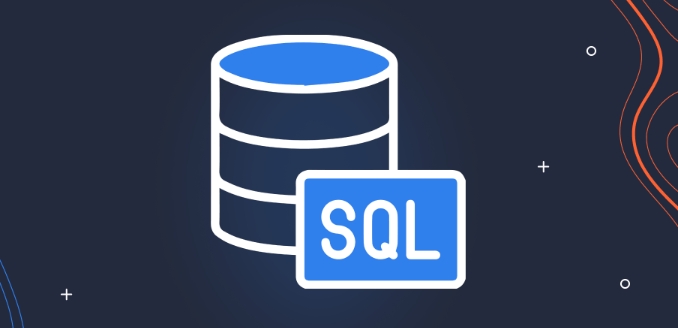SQL partitioning strategies can significantly improve performance when processing large-scale data. Divide data suitable for time attributes by time, such as logs and orders, and use range partitioning to improve query efficiency; hash partitioning is suitable for scenarios retrieved through ID, so that the data is distributed evenly and avoids hot spots; list partitioning is suitable for clear classification situations, such as regions, status, etc., which is easy to manage; the selection of partition keys is crucial, and common filtering conditions should be selected and fields should be avoided frequently updated. A rational design can improve performance, otherwise it will increase costs.

When you need to process large-scale data, SQL partitioning strategies become an important means to improve database performance and scalability. It is not a master key, but it is very effective if used correctly.

Dividing by time is the most common way
If your data has obvious time attributes, such as logs, orders, access records, etc., Range Partitioning is almost the default choice based on time. For example, by dividing tables or partitions by month, querying data for the last week or month can bypass historical cold data, which is much more efficient.
- Suitable for scenarios where frequent writing and queries are concentrated on the latest data
- The partition granularity can be days, weeks, and months, and it can be adjusted according to the service frequency.
- Pay attention to whether the time field is increasing monotonically, otherwise it will easily lead to partition confusion
For example: You have an order table, which adds millions of new data every day, but 90% of the queries are for orders in the last 30 days. At this time, split the table into multiple partitions by day, which can greatly reduce the number of scanned rows.

Hash partitions are suitable for evenly distributed data
When your query conditions do not depend on time, but are often retrieved through a certain ID (such as user ID, order ID), hash partitioning is more suitable. It can break the data into multiple partitions to avoid single hotspots.
- Choose the hash key well and try to choose fields with high cardinality and even distribution.
- Not suitable for range query because the data is discrete
- Suitable for scenarios where reading and writing balance and data distribution is not obvious
For example, a user information table, the query entry is the user ID. In this case, using hash partition can effectively distribute the load and improve concurrency capabilities.

List partitions are suitable for clear classification
List Partitioning is also very practical in certain specific scenarios, such as partitioning according to limited sets such as region, state, and type. Its advantages are clear logic and easy management.
- Classification must be clear and cannot be crossed
- Suitable for static classification, such as country, city, equipment type, etc.
- You can combine other partitioning methods to make combination partitions (for example, first partition by state, and then sub-partition by time in each state)
For example, you have an order system, and the order status is divided into "to be paid", "paid", "completed", and "cancel". Then you can use the status to partition the list, so that batch operations of different states will be more efficient.
Partition key selection is more important than policy
No matter which partition strategy you use, the selection of partition keys is the key among the keys . If the wrong key is selected, the partition may not have the expected effect and may even affect performance.
- The partition key is best used filtering conditions in queries
- Avoid using frequently updated fields as partition keys
- If the writing pressure is high, consider using the self-increment primary key partition key separation design
To give a practical example: if your query often uses user ID, but the writing is concentrated on several IDs, the hash partition may cause hot issues. At this time, you can consider combining strategies or add an intermediate buffering mechanism.
Basically that's it. Partitioning is not a one-time solution, and needs to be designed in combination with business models and query habits. If done well, the performance will be significantly improved; if done poorly, the maintenance cost will be increased.
The above is the detailed content of SQL Partitioning Strategies for Scalability. For more information, please follow other related articles on the PHP Chinese website!

Hot AI Tools

Undress AI Tool
Undress images for free

Undresser.AI Undress
AI-powered app for creating realistic nude photos

AI Clothes Remover
Online AI tool for removing clothes from photos.

Clothoff.io
AI clothes remover

Video Face Swap
Swap faces in any video effortlessly with our completely free AI face swap tool!

Hot Article

Hot Tools

Notepad++7.3.1
Easy-to-use and free code editor

SublimeText3 Chinese version
Chinese version, very easy to use

Zend Studio 13.0.1
Powerful PHP integrated development environment

Dreamweaver CS6
Visual web development tools

SublimeText3 Mac version
God-level code editing software (SublimeText3)
 Defining Database Schemas with SQL CREATE TABLE Statements
Jul 05, 2025 am 01:55 AM
Defining Database Schemas with SQL CREATE TABLE Statements
Jul 05, 2025 am 01:55 AM
In database design, use the CREATETABLE statement to define table structures and constraints to ensure data integrity. 1. Each table needs to specify the field, data type and primary key, such as user_idINTPRIMARYKEY; 2. Add NOTNULL, UNIQUE, DEFAULT and other constraints to improve data consistency, such as emailVARCHAR(255)NOTNULLUNIQUE; 3. Use FOREIGNKEY to establish the relationship between tables, such as orders table references the primary key of the users table through user_id.
 Key Differences Between SQL Functions and Stored Procedures.
Jul 05, 2025 am 01:38 AM
Key Differences Between SQL Functions and Stored Procedures.
Jul 05, 2025 am 01:38 AM
SQLfunctionsandstoredproceduresdifferinpurpose,returnbehavior,callingcontext,andsecurity.1.Functionsreturnasinglevalueortableandareusedforcomputationswithinqueries,whileproceduresperformcomplexoperationsanddatamodifications.2.Functionsmustreturnavalu
 Using SQL LAG and LEAD functions for time-series analysis.
Jul 05, 2025 am 01:34 AM
Using SQL LAG and LEAD functions for time-series analysis.
Jul 05, 2025 am 01:34 AM
LAG and LEAD in SQL are window functions used to compare the current row with the previous row data. 1. LAG (column, offset, default) is used to obtain the data of the offset line before the current line. The default value is 1. If there is no previous line, the default is returned; 2. LEAD (column, offset, default) is used to obtain the subsequent line. They are often used in time series analysis, such as calculating sales changes, user behavior intervals, etc. For example, obtain the sales of the previous day through LAG (sales, 1, 0) and calculate the difference and growth rate; obtain the next visit time through LEAD (visit_date) and calculate the number of days between them in combination with DATEDIFF;
 How to find columns with a specific name in a SQL database?
Jul 07, 2025 am 02:08 AM
How to find columns with a specific name in a SQL database?
Jul 07, 2025 am 02:08 AM
To find columns with specific names in SQL databases, it can be achieved through system information schema or the database comes with its own metadata table. 1. Use INFORMATION_SCHEMA.COLUMNS query is suitable for most SQL databases, such as MySQL, PostgreSQL and SQLServer, and matches through SELECTTABLE_NAME, COLUMN_NAME and combined with WHERECOLUMN_NAMELIKE or =; 2. Specific databases can query system tables or views, such as SQLServer uses sys.columns to combine sys.tables for JOIN query, PostgreSQL can be used through inf
 How to create a user and grant permissions in SQL
Jul 05, 2025 am 01:51 AM
How to create a user and grant permissions in SQL
Jul 05, 2025 am 01:51 AM
Create a user using the CREATEUSER command, for example, MySQL: CREATEUSER'new_user'@'host'IDENTIFIEDBY'password'; PostgreSQL: CREATEUSERnew_userWITHPASSWORD'password'; 2. Grant permission to use the GRANT command, such as GRANTSELECTONdatabase_name.TO'new_user'@'host'; 3. Revoke permission to use the REVOKE command, such as REVOKEDELETEONdatabase_name.FROM'new_user
 What is the SQL LIKE Operator and How Do I Use It Effectively?
Jul 05, 2025 am 01:18 AM
What is the SQL LIKE Operator and How Do I Use It Effectively?
Jul 05, 2025 am 01:18 AM
TheSQLLIKEoperatorisusedforpatternmatchinginSQLqueries,allowingsearchesforspecifiedpatternsincolumns.Ituseswildcardslike'%'forzeroormorecharactersand'_'forasinglecharacter.Here'showtouseiteffectively:1)UseLIKEwithwildcardstofindpatterns,e.g.,'J%'forn
 How to backup and restore a SQL database
Jul 06, 2025 am 01:04 AM
How to backup and restore a SQL database
Jul 06, 2025 am 01:04 AM
Backing up and restoring SQL databases is a key operation to prevent data loss and system failure. 1. Use SSMS to visually back up the database, select complete and differential backup types and set a secure path; 2. Use T-SQL commands to achieve flexible backups, supporting automation and remote execution; 3. Recovering the database can be completed through SSMS or RESTOREDATABASE commands, and use WITHREPLACE and SINGLE_USER modes if necessary; 4. Pay attention to permission configuration, path access, avoid overwriting the production environment and verifying backup integrity. Mastering these methods can effectively ensure data security and business continuity.
 Explain the Distinction Between a SQL Schema and a Database.
Jul 05, 2025 am 01:31 AM
Explain the Distinction Between a SQL Schema and a Database.
Jul 05, 2025 am 01:31 AM
OK, please provide the article content that needs a summary.






